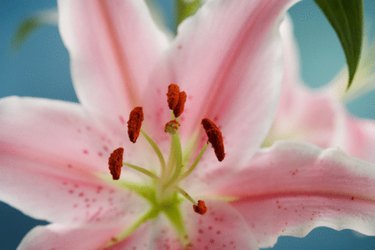Things You'll Need
Magnifying glass
Tweezers
Small, sharp pointed scissors
Small camel-hair paintbrush
Small vials
Alcohol
Cotton swabs
Cellophane bags
String
Tags
Notebook

The goal of flower breeding is the creation of new flowers that would not normally be found in nature. By selecting two flowers of the same species with different traits -- such as color, height or bloom type -- and cross-pollinating them, seeds that combine the traits of both plants will be produced. The seeds produced are F1 hybrids that will grow into new, different plants. Not all flowers are candidates for cross breeding, as some have natural inhibitors to prevent crossing.
Step 1
Select different varieties of the same species of parent flowers. Neither parent can be a hybrid, or unpredictable results will occur. The parent flowers should always be the same, using the same variety to supply the ovules and the other variety to supply the pollen.
Video of the Day
Step 2
Snip the filaments and anthers off the flower, which will supply the female parts. Hold the filament with a tweezers and cut the filament below the tweezers. Do not allow the anther to touch the center portion of the flower. Removal of the anthers ensures the flower will not self-pollinate and ruin the cross. Call this flower the female flower.
Step 3
Obtain pollen from the flower that is supplying the male parts. To store pollen, collect it from the anthers with a small camel hair brush and brush it in a vial. Label the vial with the flower species and type. Clean the brush with alcohol before using it to collect a different type of pollen. You can also gather pollen for immediate use by removing the filaments and anthers from the male flower as was done with the female flower.
Step 4
Fertilize the female flower with pollen. Dab the brush in the pollen grains in the vial and gently brush the pollen onto the emasculated female flower's stigma. For immediate use of pollen, simply collect the anthers from the male plant and use the anthers to brush pollen onto the stigma of the female plant. Immediately cover the female flower with a cellophane bag and tie it closed with a piece of string to prevent contamination with other pollen. Tag and label the female flower as a cross with the male by listing the variety of male and female.
Step 5
Collect the seeds from the female flower once they are ripe. Usually this occurs when the flower is wilted and dry, although readiness varies by species. Label the seeds for storage as the cross of the two varieties selected. Good record keeping is a must when experimenting with flower breeding.
Step 6
Keep notes in a notebook about the results of the breeding experiments. Add pictures of flowers and detailed descriptions of the hybrid plants created. Experiment with crossing the male of one variety with the female of another and also the reverse to see if the results are different.
Tip
Perfect flowers are those that have both male and female parts. Other flowers are male or female. Some plants produce both male and female flowers on the same plant, while others produce all male flowers on one plant and all female flowers on another plant.
Some perfect flowers pollinate themselves as the flower opens. Just before the flowers open, gently pry the petals open to expose the flower. Remove the anthers from the female flowers and fertilize with the pollen from the male flowers.
Warning
Good hygiene is a must. Clean hands and clean tools are necessary to prevent contamination. Wash hands and tools with alcohol before beginning work.
Video of the Day